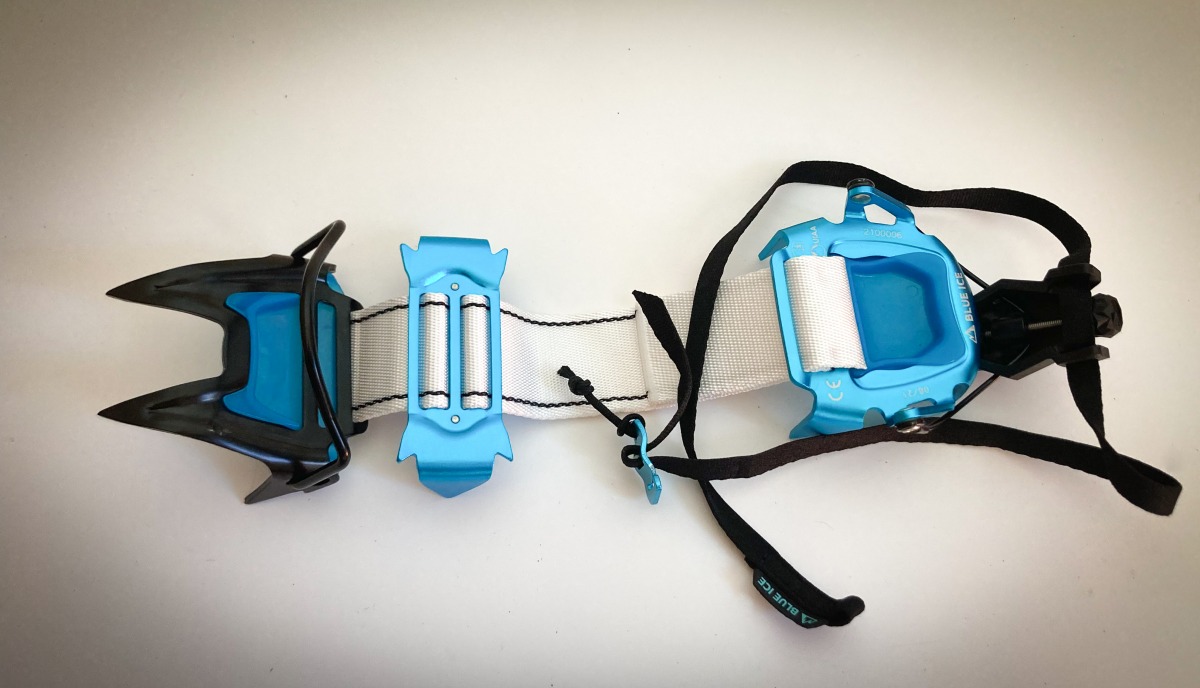
The new Blue Ice Harfang crampon. Steel front, aluminum mid and rear sections, and an innovative textile connecting it all.
First look gear reviews will be WildSnow’s quick-hit rundown of the gear we will be testing/reviewing in-depth for the season. Basics, like specs, fit, and innovations, will be highlighted. It’s also an opportunity to allow readers to chime in and ask questions that we can explore during the test season.
The Blue Ice Harfang crampon exudes modernist sensibilities. It boasts a metallic-blue sheen, a compact package with a big punch, and a mix of materials making the Harfang as much at home in the mountains as an exemplar of high design. Our job here at WildSnow is to pull back the sheen, look past the hype, and determine long-term functionality.
In our first look, here’s what the Harfang is: a minimalist 10-point crampon with aluminum points on the rear and mid-foot and steel upfront. That’s right, a three-section crampon. But most striking, Blue Ice uses a flexible UHMWPE and HTPE 40mm textile to connect the front, middle, and rear crampon sections. (More on this in a bit.)
Blue Ice is not the first to the compact, lightweight crampon show, CAMP has been in the minimalist crampon game for years with their XLC Nanotech. This camp model is an all-aluminum affair beside the affixed stainless steel front points.
Petzl upped the design game with the introduction of the Leopard LLF and Irvis HYBRID. Both models use tensioned high-modulus polyethylene (HMPE) cord to connect the rear and front crampon sections. The Irvis, the heavier of the two, features a steel front section.
The upshot, these crampons fold into a tidy package and have reduced weight; absent anti-ball/snow-plates, the Leopard LLF weighs 320g per pair, whereas the Irvis HYBRID‘s’ weight, according to Petzl, is 570g per pair. This model incorporates anti-ball / snow plates.
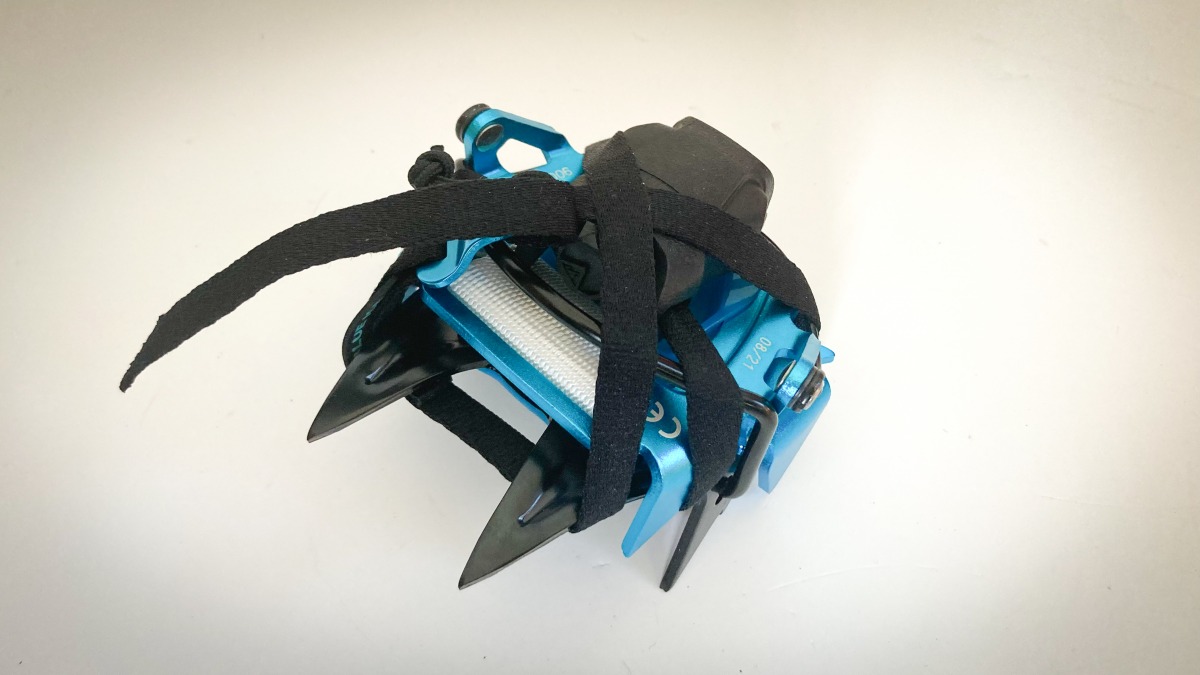
Lightweight and compact: the Blue Ice Harfang.
The Harfang is closest to the Irvis HYBRID by comparison, in that both feature a steel front section and anti-snow plates. Wildsnow’s review pegged the Irvis HYBRID at 539g for a pair or 269.5g on each boot.
For gram counters, the Harfangs tip scales at 222g / crampon. The unit weighs 482g (442g without the pouch), with crampons concealed in the stuff sack. Attaching the crampon storage bag to a pack’s waist belt is easy and makes for quick crampon access. (I don’t particularly like rifling through a backpack to access crampons in steep terrain.) If all this sounds too heavy, the snow plates are removable.
Why steel? Aluminum is lighter and softer than steel. It’s excellent for cramponing on firm snow and adequate for softer ice, but it can wear quickly and bend or break in mixed terrain. And aluminum front points do not penetrate as well as steel points. To be clear, the Harfangs are not crampons for extended mixed terrain; they are a well-rounded tool for ski-mountaineering even when encountering some rock or bullet-proof ice. That’s where the steel front section pays dividends.
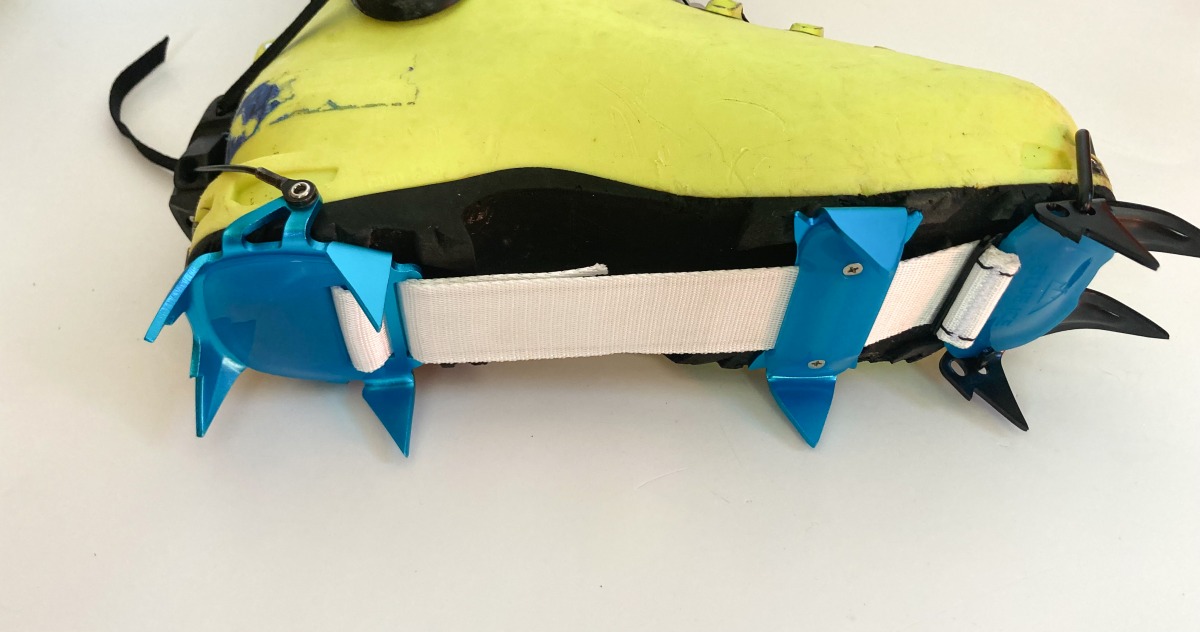
Blue Ice uses a flexible UHMWPE and HTPE 40mm textile to connect the front, middle, and rear crampon sections.
The Harfangs are fully automatic crampons. A chromoly-steel toe bail locks over the ski boot’s toe, and a coated steel cable secures onto the heel. Two pivot points fix the steel cable to the rear crampon section. The plastic heel lever features the ability to make micro-adjustments for a more fine-tuned fit.
Let’s get back to what truly sets the Harfang apart.
They are über compact when stowed, and we’ve mentioned the lightness. And although the IRVIS Hybrid and Harfang both feature 10 points, they are distributed differently. Traditionally, crampons slotted into the ski mountaineering niche have six points on the front section and four on the rear.
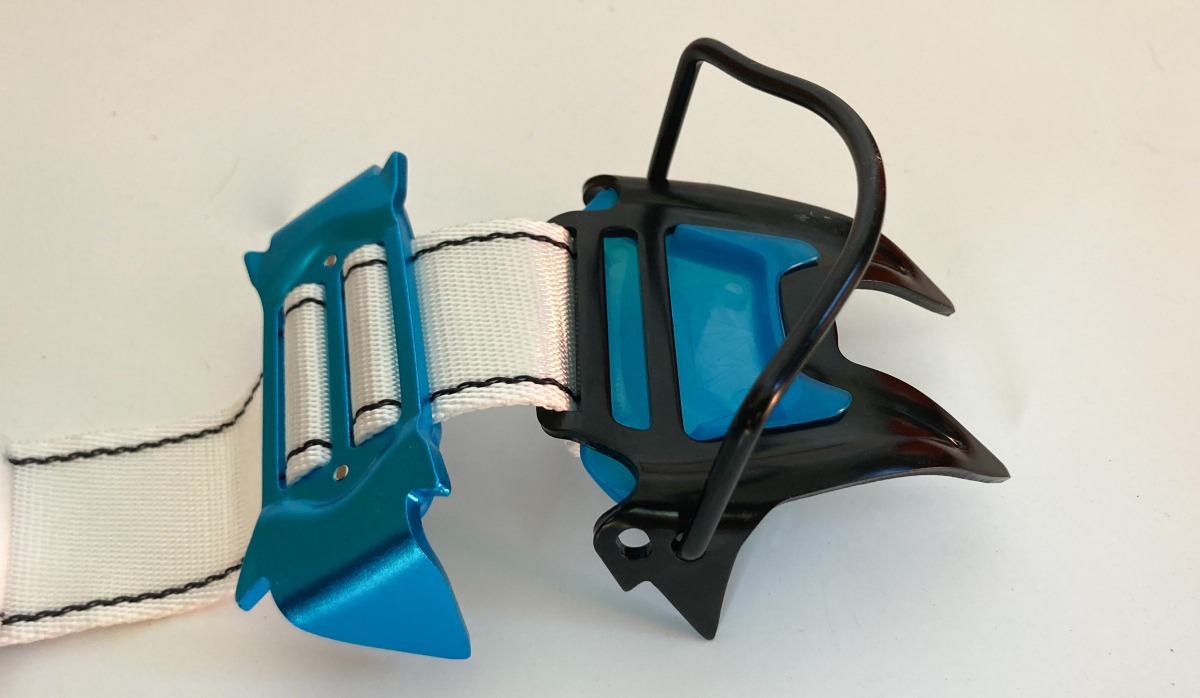
The front section of the Harfang is steel with four points, the two-pointed mid section is aluminum.
The Harfang deviates from that norm. A two-point aluminum section sits a few inches behind the front. (It too features a snow plate.) Loosening two screws allows the mid-section to be moved front or back depending on your position preference or boot sole length. (Whether two points a bit further back than a traditional six-point front section offers more security is something we’ll be looking at.)
Then there’s the two-inch textile connecting all three sections – the rear, middle, and front.
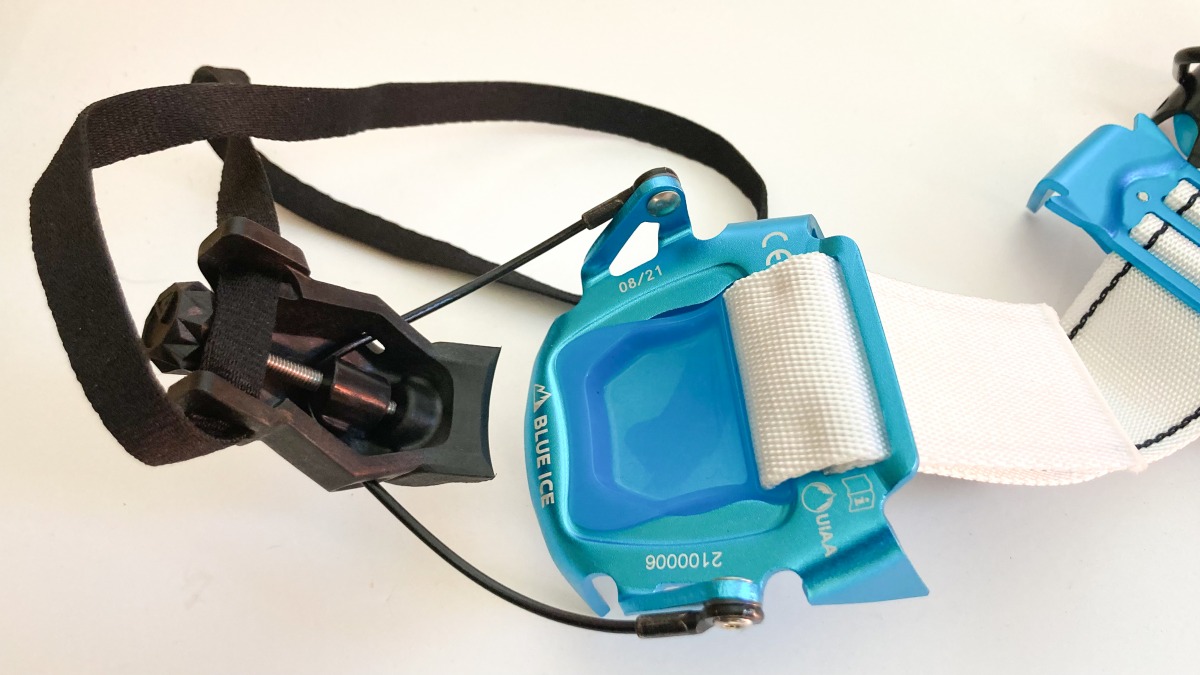
Micro-adjustment on the heel lever and an easy system to adjust for different boot sole lengths.
Adjusting the material to accommodate boot sizes is a breeze – the fabric is threaded through the rear section and is double-backed for security. (Think climbing harness buckle.) According to Blue Ice, the Harfangs fit sizes 35EU – 46EU.
Nearing the end of this first look, the big thing on my mind, and I’m assuming yours, is the long-term durability of the 40mm main strap? This type of fabric is not new to mountain environments. Dyneema, a similar but proprietary textile used for pack fabric and climbing slings, has been ground-truthed for a while. The cords connecting the crampon sections in the Petzl models cited above are Dyneema. Although, the 40mm fabric used for the Harfang has a much larger surface area than the cord.
Beyond the nuts and bolts, the Harfang‘s aesthetics are lovely. The units are designed and engineered in Salt Lake with feedback from the Chamonix home office. According to Blue Ice, they will be expanding their crampon lines in 2022 – with all models, including the Harfang, shipping with a toe basket for a semi-auto option for the front section.
The Harfang sells for $189.95. We’ll have more on the Harfang when cramponing season hits.
Shop for the Blue Ice Harfang.
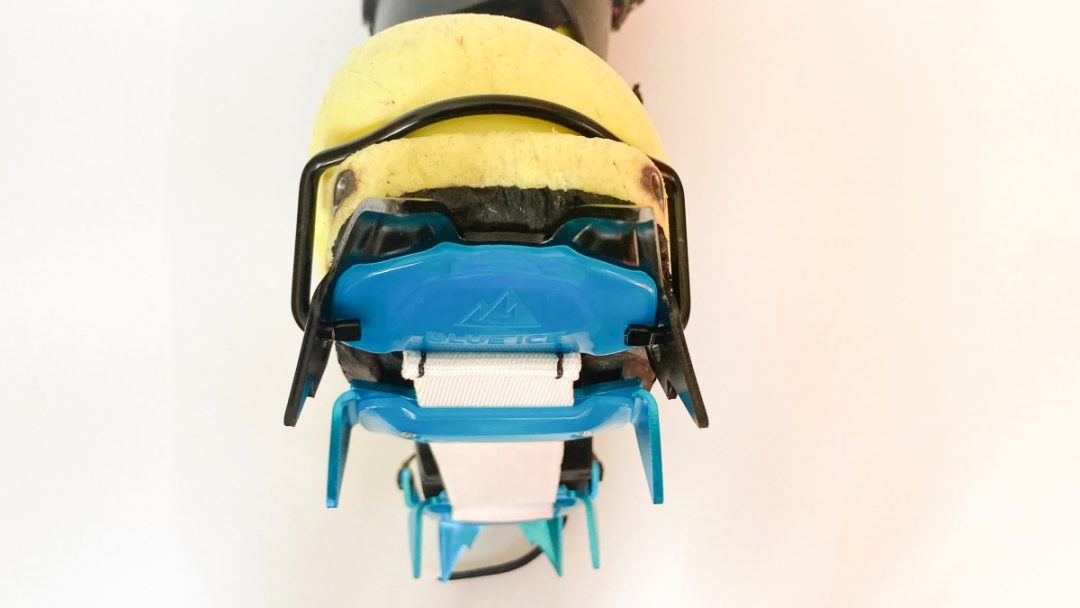
With steel front points and a minimalist design, the 222g / crampon Blue Ice Harfang checks the compact and lightweight boxes.
Jason Albert comes to WildSnow from Bend, Oregon. After growing up on the East Coast, he migrated from Montana to Colorado and settled in Oregon. Simple pleasures are quiet and long days touring. His gray hair might stem from his first Grand Traverse in 2000 when rented leather boots and 210cm skis were not the speed weapons he had hoped for. Jason survived the transition from free-heel kool-aid drinker to faster and lighter (think AT), and safer, are better.
